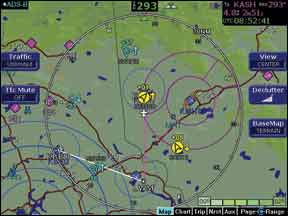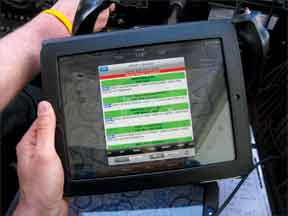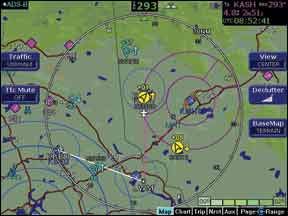If you have an IFR-certified GPS with WAAS in your panel, you’re already equipped to take advantage of the bulk of what NextGen has to offer GA today. There, don’t you feel better?

The reason is that NextGen is a fat catch-all for a host of technologies that mostly target airlines and major airport ground ops. Biz jets will reap some of the airline-focused bennies, but for the bulk of GA, NextGen boils down to RNAV instrument approaches and ADS-B. And it will likely remain that way for the next decade at least.
Easy Call: Go WAAS
Tackling the easy decision first, we think any panel work that includes an IFR GPS installation should be a WAAS unit. You could save some bucks with a used KLN 94 or just repairing your 430 without turning it into a 430W, but you’ll be shortchanging your IFR capability. This is no trivial gain; LPV approaches (the GPS equivalent to an ILS) outnumber ILSs over two to one. That ratio exceeds four to one if you count all GPS approaches that have vertical guidance of some kind.
The other reason to go WAAS, perhaps even for a VFR-only aircraft, is that WAAS GPS can be the position source for your ADS-B solution. Technically, this doesn’t have to be a WAAS GPS, but for GA, it’s simpler to just to assume it does. Any new model from a major manufacturer will work in this role, as will a Garmin GNS 430W/530W or GNS 480. Those legacy units will require a software upgrade to be an ADS-B position source, but Garmin has told us that will be offered free of charge.
A similar logic applies if you’re looking at a used G1000-equipped aircraft: Get one that’s already WAAS equipped, or factor in a conversion cost north of $10,000. ADS-B software upgrades for these will be through the OEM, so the cost will vary. All Avidyne R9 aircraft are WAAS.
Bill Stone of Garmin told us that virtually all the Garmin WAAS GPS navigators could handle the complex curved paths that make up the fanciest NextGen instrument approaches. It’s unlikely GA will see curving paths to a decision altitude soon (or maybe ever) but our navigators have the potential. Stone points out that such an upgrade for a sunsetting product like the 430 is unlikely, but a new GTN would be ready if the FAA gave such things a green light.
Complex approaches bring autopilots into the mix because it’s possible such approaches would require an autopilot. We only know of two common GA autopilots fully capable of handling the complex RNAV approaches: Avidyne’s DFC 90/100 and OEM installs of Garmin’s GFC 700 autopilot. An S-Tec 55X or Bendix-King autopilot might be hacked to work, but don’t count on it.
We wouldn’t go out of our way to ensure we had one of these autopilots today, but future capability should at least factor into the buying decision. Likewise, the announced Avidyne IFD 540 nav/comm uses digital radios. While that means little today, it lays the groundwork for digital clearances and other goodies that might be available before the box becomes obsolete. Garmin’s new GTN series uses traditional analog radios. Not a critical factor by any means—it may never matter—but it’s still worth factoring in.
ADS-B: 1090ES for All?
ADS-B purchase planning is a stickier wicket. It helps to clarify the four equipment components involved. Two are required, two are not.

By 2020, all aircraft flying in the bulk of U.S. airspace must have an approved GPS position source and a transmitter that sends that position and additional aircraft data out to air traffic control. Those two items together are ADS-B Out. The transmitter can operate on one of two frequencies, 1090 MHz (the same as a transponder) or 978 MHz.
The other two components are reception of traffic targets around your aircraft, which can be sent to you on 1090 MHz or 978 MHz, and datalink weather, which is only transmitted on 978 MHz. Those two components share the name ADS-B In, even though they are completely separate services.
To make things a bit more complex, the 1090 MHz solutions require separate boxes. There’s a 1090ES transponder to satisfy the broadcast of your position, and a 1090 MHz traffic receiver to show other traffic to you. The 978 MHz solutions usually use an all-in-one box that both transmits and receives your traffic position.
In practice, however, you may have only one choice. All aircraft that fly above 18,000 feet or travel internationally must use 1090 for their ADS-B Out. Canada hasn’t officially ruled just yet, but it’s likely they’ll require 1090. This makes going the UAT route either forbidden or potentially limiting for many aircraft. Who wants to invest up to $10,000 in a system that prevents you from travelling outside the U.S.? (Hold that thought.)
The cheapest route to ADS-B Out compliance is a $1200 upgrade to an existing Garmin GTX 330 (or GTX33) to make it a GTX 330ES, and then connecting that GTX 330ES to an approved GPS position source. For many aircraft, that connection already exists and only needs the aforementioned software upgrade.
Congratulations, you’re compliant with ADS-B out. G1000 aircraft are almost universally equipped with a blind-mounted version of the GTX 330, so the same upgrade path applies, but costs will be set by the OEMs.
If you don’t have a GTX330, you can buy a new GTX330ES or Avidyne AXP340 transponder for about $6000. The Avidyne unit has the benefit of being a slide-in replacement for the Bendix King KT76A/KT78A transponders. However, those transponders didn’t have a GPS connection, so if you want ADS-B out, you’ll have to factor in that connection—which could eliminate any benefit of a slide-in replacement.
These are both great transponders with a host of features, but it’s worth considering as we’ll the Trig Avionics TT31. The TT31 fits the tray for the KT76A and meets the ADS-B out requirement (when connected to a suitable GPS) for $3254. Trig also has its TT2X series of remote-mounted transponders and control heads. Pricing on these are $2100-$2500 and they are real panel space savers. We can’t speak to the long-term durability of Trig equipment, but we’ve been impressed with the company’s designs so far.
We can see logic in upgrading to one of these systems if you have to spend $1500-2000 to replace a failing Mode-C transponder anyway. Even under ADS-B, you must maintain a Mode-C transponder. The 1090ES transponders satisfy both that Mode-C requirement and the ADS-B requirement in one stroke, so you’re leveraging your repair costs toward the inevitable upgrade.
The other potential reason is to get ADS-B traffic in, but there’s a product hole here. Both Garmin and Avidyne have combination systems that employ both active traffic (they directly interrogate other transponders) and receive ADS-B traffic, the GTN 800 series and TAS 600A series respectively. Actually, only the Garmin system currently does both active traffic and ADS-B. The Avidyne system will do both with an upgrade due next year. The Garmin system starts at $9995. The Avidyne one starts at $8490, but the ADS-B upgrade will cost “under $2000,” so we consider the two systems roughly equivalent.

Active traffic is terrific, but expensive. Avidyne and Garmin tell us they are considering passive systems that only use ADS-B data, but can’t offer prices or timelines. Trig’s TA60 series promises to do exactly this with certification by year’s end and prices starting around $2000. Even factoring in an installation cost of running the traffic data to an existing MFD or handheld GPS, this could make a compelling traffic solution for those who fly in congested areas with good radar coverage.
Why does radar matter? Here comes another part of the ADS-B puzzle. If your aircraft broadcasts a 1090 MHz ADS-B signal that’s received by an FAA ground station—whose coverage area should be equivalent to FAA radar by 2013—that ground station will transmit back to you a custom picture of traffic around your location. That traffic picture includes all ADS-B traffic it sees and all traditional transponder traffic it sees. If you’re out of sight from a ground station, you won’t get that traffic data. However, you will still see any other traffic broadcasting ADS-B on 1090 directly from their broadcasting transponder.
For an aircraft that flies in areas of good radar coverage, doesn’t have a traffic system but has an MFD (or portable) capable of displaying traffic, the one-two combination of a 1090ES transponder and a passive ADS-B in traffic system could make real sense and come in we’ll under $10,000 installed. But remember, that system will never receive free datalink weather.
UAT Fights Back?
Even though the 978 MHz UAT is only a realistic option in the U.S. and under 18,000 feet, FreeFlight Systems thinks it’s the right choice for many aircraft. Why? Because it’s low weight, low power and can be made cheaply. “We’re an absolutely low-cost solution,” says Peter Ring, a regional sales manager for FreeFlight. This would be a welcome change in the UAT world, as the only certified one to date is the Garmin GDL 90, which costs $8000.
FreeFlight hopes to have TSO and STCs to install their Ranger UATs on Cessna 172s and 182s, Piper PA24s and PA28s, and the Augusta 139 helicopter by early next year. The $4995 system uses an approved GPS for position, but for 6995 you can get one with a GPS built in. This is a welcome option for basic VFR aircraft and modern light sport, as many won’t have the approved GPS position source even though they have upgradable transponders. A UAT might be just the ticket.
Modern LSAs are an interesting conundrum with ADS-B. The FAA has said that approved ADS-B installations will be by STC only, but the STC process doesn’t apply to LSAs (or experimentals, for that matter).
Because the UAT both transmits and receives, these aircraft will be compliant with the ADS-B rule and get both traffic and free weather data when they are in range of a ground station.
That data must be displayed somewhere, but FreeFlight has some ideas. They will be compatible with the Garmin GMX200 and Chelton displays initially, but will also offer a $79 Wi-Fi module to display both weather and traffic on an iPad. It’s important to note that the Wi-Fi will supply both the data and the GPS position from the Ranger WAAS GPS. Because the traffic is relative to the aircraft’s own location, an accurate GPS position is essential for traffic awareness. We’d expect display on systems like the Dynon Skyview or G300 would come soon if the LSA equipage caught on.
Any DME or transponder antenna will work for a UAT. You can even diplex both a UAT and a transponder to share one antenna. However, you must still maintain a Mode-C or better transponder with a UAT, so it’s two boxes that could fail over time.

Both the transponder and the UAT get a squawk code, and that squawk code must be entered in only one place. Modern transponders have a serial output that can connect to the Ranger UAT, but older transponders will need a detector that FreeFlight is developing. It listens to the transponder squawk and sends that code over to the UAT. It will cost an extra $269.
Practicalities
While FreeFlight’s UAT argument has legs, we think the uncertainty of Canadian airspace hobbles it. FreeFlight CEO Tim Taylor even admits that an aircraft flying into Canada regularly shouldn’t invest in a UAT, at least not yet.
The other problem with the UAT is that below radar coverage UAT aircraft can only see other UAT aircraft and 1090ES aircraft can only see 1090ES aircraft. If the majority of aircraft have 1090ES and you have UAT, you’re blind to them and they can’t see you. (Except with eyes, of course.) But don’t worry, no-radar only happens down low, like around uncontrolled airports, right?
We think this makes 1090ES the more practical solution, assuming you have a suitable GPS to drive it. You could use 1090 MHz for your ADS-B out and traffic in, and get the free weather independently with a separate 978 MHz receiver (no transmitter). SkyRader LLC and NavWorx sell portable units that display weather on iPads and the like for $950-1400.
Garmin, Avidyne and FreeFlight all indicated they are considering certified ADS-B receiver-only devices, similar to an XM weather receiver but without the monthly subscription cost. The 978 MHz band has lots of bandwidth that could be used for all sorts of as yet unplanned data, so it’s far from dead as a resource even if it’s not used for traffic. That said, ADS-B weather isn’t quite as capable as XM weather. You must be airborne to receive it, and it only shows weather with a given range of your aircraft (see AIM table 7-7-1 for details). Pressure from competition could spur WXWorx to expand their XM weather offerings.
The ADS-B rule allows for an aircraft to broadcast ADS-B on 1090MHz and listen for both traffic and weather on 978 MHz. That might make for the cheapest and most capable solution of all. You’d upgrade your transponder to a 1090ES model for ADS-B out and then just listen on 978 for both traffic and weather ADS-B In. This receiver could be an uncertified portable unit so long as it displayed on a portable display. The catch is that the portable better have a rock-solid GPS position, however. There could be some engineering to prevent seeing your own ship as traffic as well.
The final rogue element here is that the 1090 MHz band is also used by transponders, TCAS, and FAA secondary radar. The FAA has been working to mitigate the potential for devastating frequency congestion as ADS-B gets added to the pot. According to Ted Lester, a Product Manager at Avidyne, the mitigations “will be pretty good, unless every GA pilot equips with 1090ES.”
There was a knowing pause in the conversation as that thought sank in. Unfortunately, we might not know how much of an issue that is until the summer of 2019.


